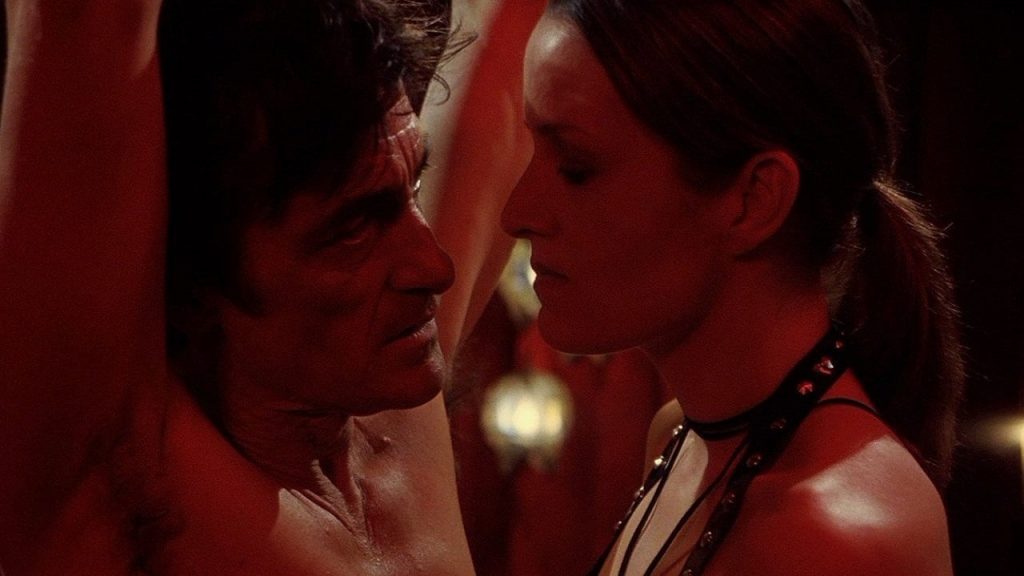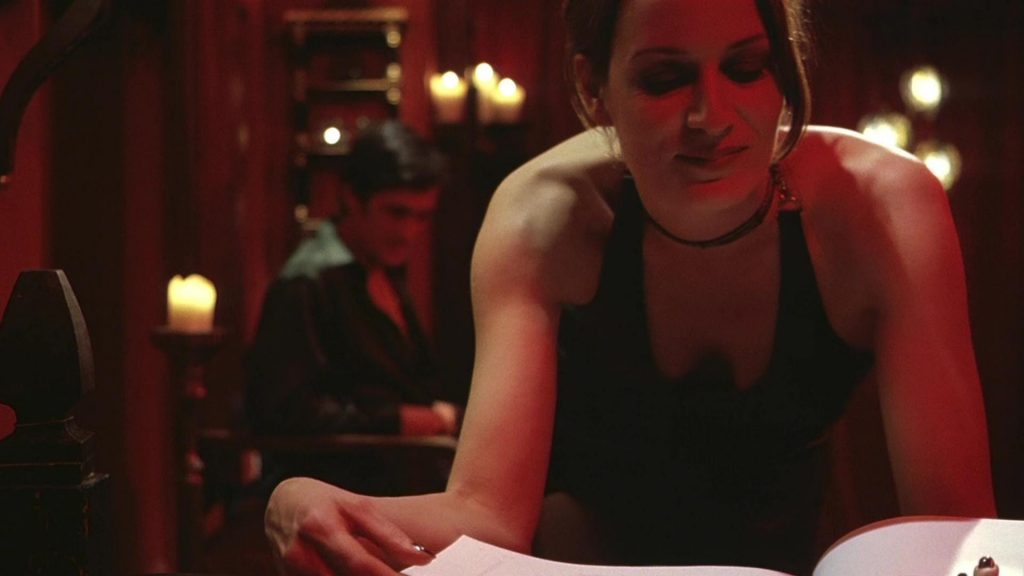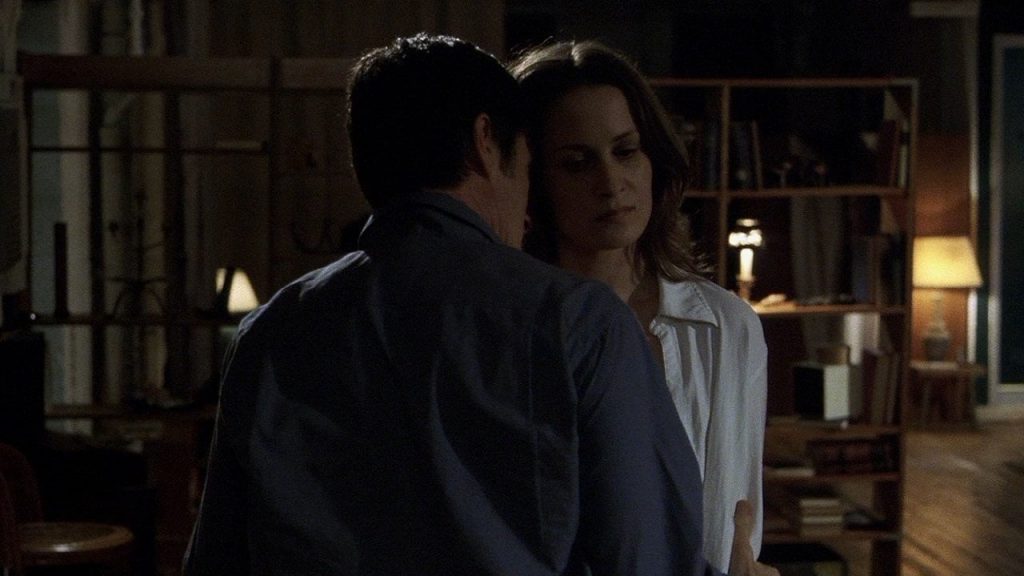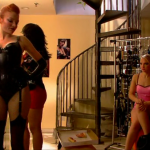Going Under is a 2004 drama film directed by Eric Werthman and written by Werthman and Jessica Gohlke. IMDB
Peter (Roger Rees), a married therapist, regularly sees a pro dominatrix, Suzanne (Geno Lechner), with the permission of his wife. On a summer when Peter’s wife is out of town and Suzanne has quit the business, they try to form a romantic relationship outside the dungeon.

Unlike a lot of films that take a romanticized or sensationalized view of BDSM, Going Under is more observational, getting into the minds and histories of the two lead characters. We get a few flashbacks about their pasts. As a child, Peter had a speech impediment and a learning disability (he tries to type a letter that is full of spelling errors), and we see the women who coached him through them. Suzanne, a young immigrant from Germany with a troubled family, got the reputation of being “the fast girl” at her school.
In the dungeon, Peter and Suzanne do have an intimate connection that is more than just transactional. When they first meet, they use pseudonyms, but later address each other by their real first names. He gives her a book about the Villa of the Mysteries in Pompeii that inspired the art project she works on in her studio.

The dungeon scenes employ the familiar red-black color scheme of filmed BDSM, but it departs from the standard tropes. The camera doesn’t linger on Suzanne’s face or body, and instead puts more emphasis on Peter’s frontally-nude body. We watch their faces more than their bodies. In the aftercare phase, she rests her head on him, and he strokes her hair.
When I discuss a filmed BDSM scene, I want to draw a distinction between realism and verisimilitude. The opening scene between Suzanne and Peter definitely falls down on realism, as Suzanne does not wear gloves or disinfect the area when she does needle-play on him. Unless you assume that Suzanne and Peter are fluid-bonded (unlikely, as they are pro-domme and client at this point), this is highly unsafe.
However, the scene does convey the subjective experience of doing BDSM, that kind of passion and intimacy. It doesn’t have realism, but it does have verisimilitude. A highly stylized drama like The Duke of Burgundy can still speak truth about kink and why people do it. Likewise, even if the scenes in Going Under don’t meet the ideal of “Safe, Sane and Consensual”, they reveal the emotions driving this female-dominant/male-submissive relationship.

At the end of the film’s opening scene, Suzanne says she’s quitting the dungeon and agrees they try seeing each other outside. Peter accepts this eagerly.
We get a look into their personal lives. Suzanne is an artist who dates women. Peter is a therapist with a wife, Pat, both at the empty-nest stage as their daughter travels in Europe. Their relationship is distant, and Pat knows that he sees pro dommes, something she accepts, but does not embrace.
Peter: “There’s a dominant that I’ve been seeing. I mean, I mean, I’ve been seeing one dominant for a while now. She told me the other day she’s going to stop working. I’ve become very attached to her.”
Pat: “Is it personal or professional, this attachment you have to her?”
Peter: “Both.”
Pat: “Both?”
Peter: “We’re going to try to get together for coffee after she’s stopped working.”
Pat: (scoffs) “Are you telling me this to reassure yourself that that’s all it’ll be?”
Peter: “No, that is all it will be. I just didn’t want you to think it was something else. I didn’t mean to…. I just wanted to tell you.”
Again, this isn’t ideal polyamory, but an arrangement.
When Peter and Suzanne meet in public, it’s awkward. Peter is nervous, and keeps looking over his shoulder as if he is afraid of being seen with her. Suzanne is tentative. Later they get a bit more relaxed, and Suzanne talks about why she decided to quit being a pro domme. She had a client she didn’t like, but let him see her, out of “perverse loyalty.”
Suzanne: “It’s more that I felt that he deserved to be humiliated, like he should be kicked around.”
Peter: “Didn’t he feel he deserved to be humiliated?”
Suzanne: “I liked hurting him, Peter.”
Peter: “Are you saying you never felt this way before?”
Suzanne: “I discovered I couldn’t distance myself from the work.”
Distance is a recurring motif. In one session, Suzanne allows Peter to kiss up her bare leg, getting closer to her sex, but then tells him to stop and go back to a lower point. The power to set, and especially to change, boundaries matters to her. Both Peter and Suzanne deal with clients in emotionally intense pairings, and they have to maintain a certain distance, just the right amount of intimacy, for their own sakes. For Suzanne to feel contempt or love or any strong emotion for her clients is a problem, and her seeing Peter may be doomed from the start.
We get a flashback of how they met in the dungeon for their first scene together, when he was “Robert” and she was “Diana”.
Peter is a fidgety, desperate wreck, constantly leaving her phone messages, which she rarely answers. Suzanne proves to be ambivalent about just about everything in her life, playing push/pull with Peter, her girlfriend Miho and her former madam, Juno.
Though she didn’t have to, Suzanne meets with Juno, who offers her a job worth several months of living expenses. Juno says no, but also asks if people (i.e. clients) still ask for her. Juno says they do.
Juno: “I wonder if you know why you’re so good at it. Why the customers really do miss you. You really could create the feeling of intimacy. Fake intimacy. But that’s why the customers kept coming back.”
Suzanne: “Maybe. But so what?”
Juno: “You’re still perverse.”
Suzanne: “There’s more than one way to express that. I’m sorry, Juno, I can’t help you out.”
During this period, Peter and Suzanne also both have unsatisfactory experiences with other partners.
Peter goes to a BDSM club (shot on location at Paddles in NYC) and has a scene with a woman named Terry. While he seems to enjoy it, he’s ultimately uncomfortable with public play and especially with Terry’s lack of pretense, compared to Suzanne’s distance.

Though Suzanne told Juno that she quit, she takes a high paying assignment. The client, Walter, is a classic top-from-the-bottom, constantly nitpicking Suzanne’s outfit and tone of voice, and even bringing up the fact that he’s paying for this, until she gags him. It’s not clear if this is Walter being a bratty sub and Suzanne is playing her part, or she is genuinely fed up with his passive-aggression; more confusion between the roles they are supposed to play and the genuine emotions. After the scene, Walter leaves money for her.
Walter: “I don’t believe we’re going to be able to continue these sessions until your whip technique improves significantly.”
Suzanne: “And I believe your session has come to an end. Unless you wish to pay for another hour.”
Walter: “And you do need to work on that voice. It’s still not quite right.”
Suzanne: “Don’t try to top me, Walter.”
He goes to the door, and stops, then gives a heartfelt “Thank you.”
He leaves, and Suzanne breaks down laughing. Then she starts crying as she pulls off her boot and her choker.
Suzanne learns that her mother has cancer. She enlists Peter to drive her upstate to meet with her mother and her brother for a very awkward family dinner. Peter gets a good look at Suzanne’s family life and how evasive she is about her real life.

Suzanne invites Peter in after he drives her home. There he sees her artwork, based on a book he gave her, and sees her at her most vulnerable and open. He’s more relaxed than he ever was outside of the dungeon. But Suzanne goes into go-away/come-back mode, and ultimately says they can’t be together.
They have one last meeting in a public place. Peter is on the brink of panicking at the thought of losing her, and apologizes and begs.
Peter: (frantic) “Let’s go out together. Let’s walk around and talk about this.”
Suzanne: “No! No, I’m not going anywhere with you together.”
Peter: “Suzanne, don’t do this.”
Suzanne: “Do what? You are the one who’s losing control. You can’t let go of the fantasy.”
Peter: “Is that all you think this has been?”
Suzanne: “All? Maybe not. But it doesn’t matter. I can’t be responsible for you.”
She leaves.
We next see Peter, apparently relaxed, visiting with his wife and daughter in the woods, where they talk about the growing distance of their teenage daughter.
Pat says Peter is private too.
Peter: “I’m scared most people won’t understand.”
Pat: “Does that include me?”
Peter: “No.”
Pat: “You do hurt me, you know.”
Peter: (apologetic) “I know. And I’m sorry.”
There’s one last phone conversation in which Peter calls Suzanne. He mentions he saw her ad in a magazine, and she says she’s working one day a week for the money. She still refuses to see him.
As discussed in Danielle J Lindemann’s book Dominatrix, pro-dommes often normalize their role by comparing themselves to healing professionals.
Suzanne says as much in the opening voice-over. “I think of you as my patient. I treat you. […] I like my work. There are rules. They protect us.”
This has problems because, first, dominatrixes want their clients to keep returning, and second, dominatrixes aren’t trained to follow psychological and ethical rules like psychiatrists and therapists, which protect both parties. Peter is an actual healing professional, a therapist, one who deals with people’s vulnerabilities in a controlled environment under strict rules for the protection of both parties. Perhaps he should have known better, but his desperation for someone to hold him together as he fears disintegrating was stronger.
Peter and Suzanne are passionate and intimate in the highly-constrained world of the dungeon. It’s when they try to get to know one another in the messy outside world, with all their emotional baggage, that they struggle.
Suzanne can tell that Peter has become dependent on her and she can’t devote her entire life to holding him together. She can’t have a romance with him for the same reason that he can’t have a romance with one of his patients. Only in the liminal space of the dungeon, under strict rules, can they meet. Outside that hothouse, whatever connection they had becomes unstable and collapses.
I don’t know why Going Under isn’t better known in the kink world. It is one of the better cinematic treatments of BDSM I seen. (I first saw it at CineKink 2005 in NYC.) I can see why it wasn’t a commercial success. It’s not a romance, it’s a low-key psychological drama. That it is about a dominant woman and a submissive man is a strike against it commercially too. It continues the tradition of submissive men and dominant women not being allowed “happily ever after.”




I’ll have to put this on my watch list. Thank you for bringing it to my attention.
[…] The show’s direction employs some standard tropes of depicting BDSM. Pete descends into a below-street-level dungeon at the beginning, just like in POSE, and the BDSM scenes are full of black and red, just like in Going Under. […]
[…] between them, but we don’t know enough about her character to understand. Compare this to Going Under, in which both the male submissive and the female dominant are fully […]
[…] with the trope of pro-dominatrix-as-caregiver that turns up so often in mainstream media. (E.g. Going Under, Personal Services). It further desexualizes an already desexualized character. In this episode, […]
[…] My friend TammyJo and I discuss Going Under (2004), which I previously discussed. […]
[…] profession, not her work itself. We never see Natalie with a client like Walter from Going Under, who pays his pro domme well but endlessly nitpicks and provokes her. She has no problems with her […]